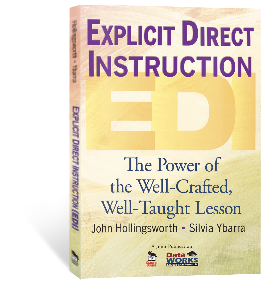
What is EDI?
Explicit Direct Instruction, or EDI, was developed by Dr. Silvia Ybarra and John Hollingsworth. They took the best practices from all versions of direct instruction and combined them with the best practices from the past 100 years of educational research. These practices include a wide variety of important concepts ranging from curriculum and lesson design, to classroom practices and lesson delivery strategies. There are two primary components in EDI that must work together: solid lesson design and effective lesson delivery strategies. EDI is designed to be the most efficient method of introducing novel material to students and has been designed to efficiently and effectively introduce students to new information and material. For more information on the particular practices and methodologies, see our books, Explicit Direct Instruction: The Power of the Well-Crafted, Well-Taught Lesson and EDI for English Learners.
Is EDI just rote repetition?
No. In a proper EDI lesson, students should be active participants and speak on a regular basis throughout a lesson. This is not, however, simple repetition of information. Student speech should be based on answering specific higher-order questions, particularly when Checking for Understanding. Rather than rote repetition, students should be answering questions, justifying their answers, and at the lowest level, rewording definitions into their own words. One of the common refrains during our training is that students should be actively engaged every 47 seconds.
How does EDI differ from Direct Instruction?
This is actually a somewhat complex subject. There are actually two different terms that direct instruction can refer to. Direct Instruction (capitalized) was developed online casino’s by Dr. Siegfreid “Zig” Engelmann during the 1960s. It is a heavily scripted program. Student interaction is primarily choral responses after a teacher signal. On the other hand, direct instruction (note the lower case) refers to research done by Dr. Barak Rosenshine in the 1970s that describes a set of effective teaching practices. Explicit Direct Instruction is a custom system of direct instruction practices that Dr. Silvia Ybarra and John Hollinsworth of DataWORKS Educational Research developed. It is built around the research of Rosenshine, Marzano, Souza, and others combined with DataWORKS’ own research. For more information comparing EDI and DI, take a look at our EDI vs. DI blog post.
What research is there to support EDI?
There is a significant amount of research that went into the development of EDI, but there has also been a significant amount of research done on effective teaching practices. Richard E. Clark, Paul A. Kirschner, and John Sweller have recently performed an analysis of the current research on effective student outcomes. According to Clark et al, “Decades of research clearly demonstrate that for novices (comprising virtually all students), direct, explicit instruction is more effective and more efficient than partial guidance.” For more information, see their article, Putting Students on the Path to Learning: The Case for Fully Guided Instruction. We also review relevant research on our blog each week.
Does EDI work with Common Core?
Absolutely! EDI should work with any set of standards to introduce new material. EDI incorporates research-based strategies to foster learning. We have seen EDI work effectively with students ranging from Transitional Kindergarten to college level. The Common Core State Standards do not call for any particular teaching methodology. For more information on the CCSS particularly, see our blog from a few weeks ago.
How can I learn more about EDI?
In addition to the EDI books mentioned earlier, we offer extensive training services. We also occasionally run introductory seminars in various locations across the country. See our home page for details, and if you have any specific questions you’d like answered, feel free to comment below or contact us directly.
